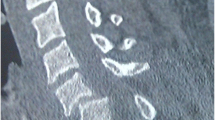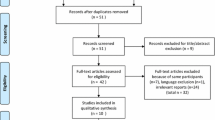Abstract
Background
Traumatic facet dislocations in the subaxial cervical spine, also known as locked facets, are commonly associated with neurological deficits. The fear of the presence of an associated traumatic disc herniation and consequent neurological worsening usually causes a delay in the spinal realignment.
This study’s aim is an analysis of safety and efficacy when treating acute cervical traumatic facet dislocations using cranial-cervical traction or posterior open reduction and fixation in the presence of disc herniations.
Methods
Inclusion criteria addressed the following patient groups: (1) MRI diagnosis of traumatic cervical facet dislocations with disc herniation, (2) intervention: either cranial-cervical traction or posterior open reduction and fixation, (4) neurological outcomes after treatment, (5) adult 18 plus years of age, (6) sample sizes greater than 20 patients, (7) English language publication. The following databases and search tools were analyzed: MEDLINE (PubMed), Cochrane Central Register of Controlled Trials (CENTRAL), Google Scholar, and the clinical trial registries (ClinicalTrials.gov), October 2021.
Results
Six studies were found, 2 with posterior open reduction and fixation and 4 with cranial-cervical traction, totalizing 197 patients. Neurological worsening was reported only in 1 case (0.5%).
Conclusions
Traumatic disc herniation in cervical facet dislocations is not an absolute contraindication of cranial-cervical traction or posterior open reduction. Early realignment of the spine could bring more neurological benefits than waiting for an MRI or surgical discectomy. However, caution is needed in this review's data interpretation until prospective and well-designed studies are performed.




Similar content being viewed by others
Abbreviations
- CCT:
-
Cranial-cervical traction
- CR:
-
Closed reduction
- PCORF:
-
Posterior cervical open reduction fixation
- ASIA:
-
American Spinal Injury Association
- MR:
-
Magnetic resonance
- ACDF:
-
Anterior cervical discectomy and fusion
- AR:
-
Additional references
References
Vaccaro AR, Falatyn SP, Flanders AE, Balderston RA, Northrup BE, Cotler JM (1999) Magnetic resonance evaluation of the intervertebral disc, spinal ligaments, and spinal cord before and after closed traction reduction of cervical spine dislocations. Spine 24(12):1210–1217
Anissipour AK, Agel J, Baron M, Magnusson E, Bellabarba C, Bransford RJ (2017) Traumatic cervical unilateral and bilateral facet dislocations treated with anterior cervical discectomy and fusion has a low failure rate. Global Spine J 7(2):110–115. https://doi.org/10.1177/2192568217694002 (PMID: 28507879)
Grant GA, Mirza SK, Chapman JR, Winn HR, Newell DW, Jones DT, Grady MS (1999) Risk of early closed reduction in cervical spine subluxation injuries. J Neurosurg 90(1 Suppl):13–18. https://doi.org/10.3171/spi.1999.90.1.0013 (PMID: 10413120)
Tang C, Fan YH, Liao YH, Tang Q, Ma F, Wang Q, Zhong J (2021) Classification of unilateral cervical locked facet with or without lateral mass-facet fractures and a retrospective observational study of 55 cases. Sci Rep 11(1):16615. https://doi.org/10.1038/s41598-021-96090-4
Nakashima H, Yukawa Y, Ito K, Machino M, El Zahlawy H, Kato F (2011) Posterior approach for cervical fracture-dislocations with traumatic disc herniation. Eur Spine J 20(3):387–394. https://doi.org/10.1007/s00586-010-1589-1
Park JH, Roh SW, Rhim SC (2015) A single-stage posterior approach with open reduction and pedicle screw fixation in subaxial cervical facet dislocations. J Neurosurg Spine 23(1):35–41. https://doi.org/10.3171/2014.11.SPINE14805 (PMID: 25909272)
Stroup DF, Berlin JA, Morton SC, Olkin I, Williamson GD, Rennie D, Moher D, Becker BJ, Sipe TA, Thacker SB (2000) Meta-analysis of observational studies in epidemiology: a proposal for reporting. Meta-analysis of Observational Studies in Epidemiology (MOOSE) group. JAMA. 283(15):2008–12. https://doi.org/10.1001/jama.283.15.2008 (PMID: 10789670)
Page MJ, Moher D, Bossuyt PM, Boutron I, Hoffmann TC, Mulrow CD, Shamseer L, Tetzlaff JM, Akl EA, Brennan SE, Chou R, Glanville J, Grimshaw JM, Hróbjartsson A, Lalu MM, Li T, Loder EW, Mayo-Wilson E, McDonald S, McGuinness LA, Stewart LA, Thomas J, Tricco AC, Welch VA, Whiting P, McKenzie JE (2021) PRISMA 2020 explanation and elaboration: updated guidance and exemplars for reporting systematic reviews. BMJ 29(372):n160. https://doi.org/10.1136/bmj.n160.PMID:33781993;PMCID:PMC8005925
Slim K, Nini E, Forestier D, Kwiatkowski F, Panis Y, Chipponi J (2003) Methodological index for non-randomized studies (MINORS): development and validation of a new instrument. ANZ J Surg 73(9):712–716. https://doi.org/10.1046/j.1445-2197.2003.02748.x (PMID: 12956787)
ASIA and ISCoS International Standards Committee, ASIA Education Committee, Rupp R. Assessor accuracy of the International Standards for Neurological Classification of Spinal Cord Injury (ISNCSCI) recommendations for reporting items. Spinal Cord 2018; 56: 819–20.
Shapiro S, Snyder W, Kaufman K, Abel T (1999) Outcome of 51 cases of unilateral locked cervical facets: interspinous braided cable for lateral mass plate fusion compared with interspinous wire and facet wiring with iliac crest. J Neurosurg 91(1 Suppl):19–24. https://doi.org/10.3171/spi.1999.91.1.0019
Vaccaro AR, Madigan L, Schweitzer ME, Flanders AE, Hilibrand AS, Albert TJ (2001) Magnetic resonance imaging analysis of soft tissue disruption after flexion-distraction injuries of the subaxial cervical spine. Spine. 26(17):1866–72. https://doi.org/10.1097/00007632-200109010-00009 (PMID: 11568695)
Eranki V, Koul K, Mendz G, Dillon D (2016) Traumatic facet joint dislocation in Western Australia. Eur Spine J. 25(4):1109–16. https://doi.org/10.1007/s00586-014-3627-x (Epub 2014 Oct 26 PMID: 25344641)
Li H, Huang Y, Cheng C, Lin Z, Wu D (2017) Comparison of the technique of anterior cervical distraction and screw elevating-pulling reduction and conventional anterior cervical reduction technique for traumatic cervical spine fractures and dislocations. Int J Surg. 40:45–51. https://doi.org/10.1016/j.ijsu.2017.02.057
Kanna RM, Shetty AP, Rajasekaran S (2018) Modified anterior-only reduction and fixation for traumatic cervical facet dislocation (AO type C injuries). Eur Spine J 27(6):1447–1453. https://doi.org/10.1007/s00586-017-5430-y (PMID: 29279998)
Jiang X, Yao Y, Yu M, Cao Y, Yang H (2017) Surgical Treatment for Subaxial cervical facet dislocations with Incomplete or without neurological deficit: a prospective study of 52 cases. Med Sci Monit. 9(23):732–740. https://doi.org/10.12659/msm.902961
Theodotou CB, Ghobrial GM, Middleton AL, Wang MY, Levi AD (2019) Anterior reduction and fusion of cervical facet dislocations. Neurosurgery 84(2):388–395. https://doi.org/10.1093/neuros/nyy032 (PMID: 29547951)
Liu K, Zhang Z (2019) Comparison of a novel anterior-only approach and the conventional posterior-anterior approach for cervical facet dislocation: a retrospective study. Eur Spine J. 28(10):2380–2389. https://doi.org/10.1007/s00586-019-06073-3
Ren C, Qin R, Li Y, Wang P (2020) Anterior reduction and fusion for acute unilateral cervical facet dislocation without severe spinal cord injuries. J Clin Neurosci. 78:102–107. https://doi.org/10.1016/j.jocn.2020.05.059 (PMID: 32624368)
Eismont FJ, Arena MJ, Green BA (1991) Extrusion of an intervertebral disc associated with traumatic subluxation or dislocation of cervical facets: case report. J Bone Joint Surg. 73:1555–1560
Mahale YJ, Silver JR, Henderson NJ (1993) Neurological complications of the reduction of cervical spine dislocations. J Bone Joint Surg Br. 75(3):403–9. https://doi.org/10.1302/0301-620X.75B3.8496208
Olerud C, Jónsson H Jr (1991) Compression of the cervical spine cord after reduction of fracture dislocations. Report of 2 cases. Acta Orthop Scand. 62(6):599–601. https://doi.org/10.3109/17453679108994506
Berrington N (1994) Locked facets and disc herniation. J Neurosurg 80(5):951–952 (PMID: 8169645)
Hadley MN, Walters BC, Grabb BC, Oyesiku NM, Przybylski GJ, Resnick DK, Ryken TC (2002) Initial closed reduction of cervical spine fracture-dislocation injuries. Neurosurgery 50(3 Suppl):S44-50. https://doi.org/10.1097/00006123-200203001-00010 (PMID: 12431286)
Fehlings MG, Vaccaro A, Wilson JR, Singh A, Cadotte WD, Harrop JS, Aarabi B, Shaffrey C, Dvorak M, Fisher C, Arnold P (2012) Early versus delayed decompression for traumatic cervical spinal cord injury: results of the Surgical Timing in Acute Spinal Cord Injury Study (STASCIS). PloS one 7(2):e32037. https://doi.org/10.1371/journal.pone.0032037
Author information
Authors and Affiliations
Contributions
Conception and design: all authors. Acquisition of data: all authors. Analysis and interpretation of data: all authors. Drafting of the manuscript: all authors. Critical revision of the manuscript: all authors. Statistical analysis: FJ Onishi and RV Botelho. Administrative/technical/material support: all authors. Study supervision: all authors.
Corresponding author
Ethics declarations
Conflict of interest
The authors have nothing to disclose.
Additional information
Publisher's Note
Springer Nature remains neutral with regard to jurisdictional claims in published maps and institutional affiliations.
Appendix
Rights and permissions
About this article
Cite this article
Onishi, F.J., Daniel, J.W., Joaquim, A.F. et al. The impact of traumatic herniated discs in cervical facets dislocations treatments: systematic review and meta-analysis. Eur Spine J 31, 2664–2674 (2022). https://doi.org/10.1007/s00586-022-07290-z
Received:
Revised:
Accepted:
Published:
Issue Date:
DOI: https://doi.org/10.1007/s00586-022-07290-z




